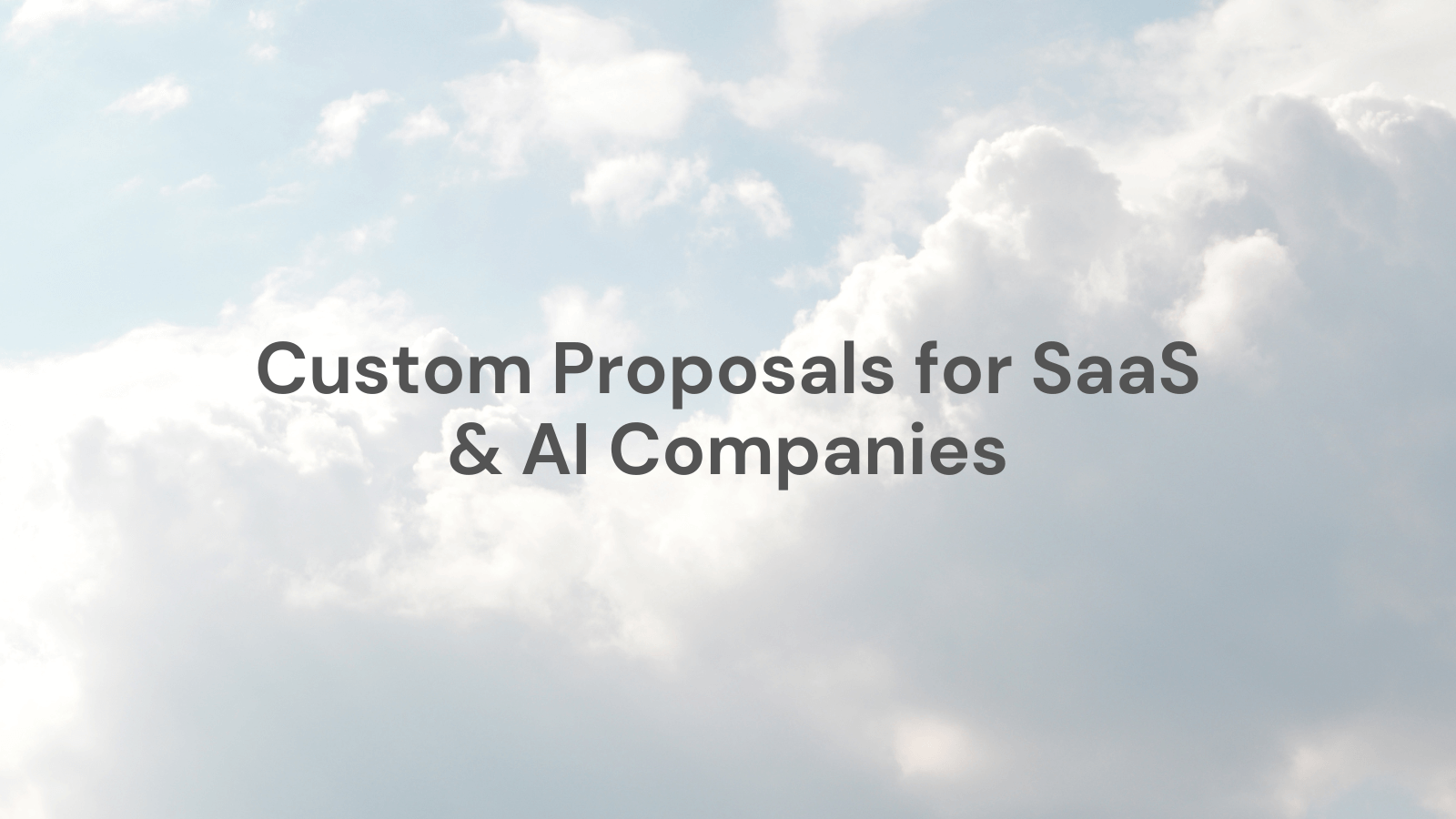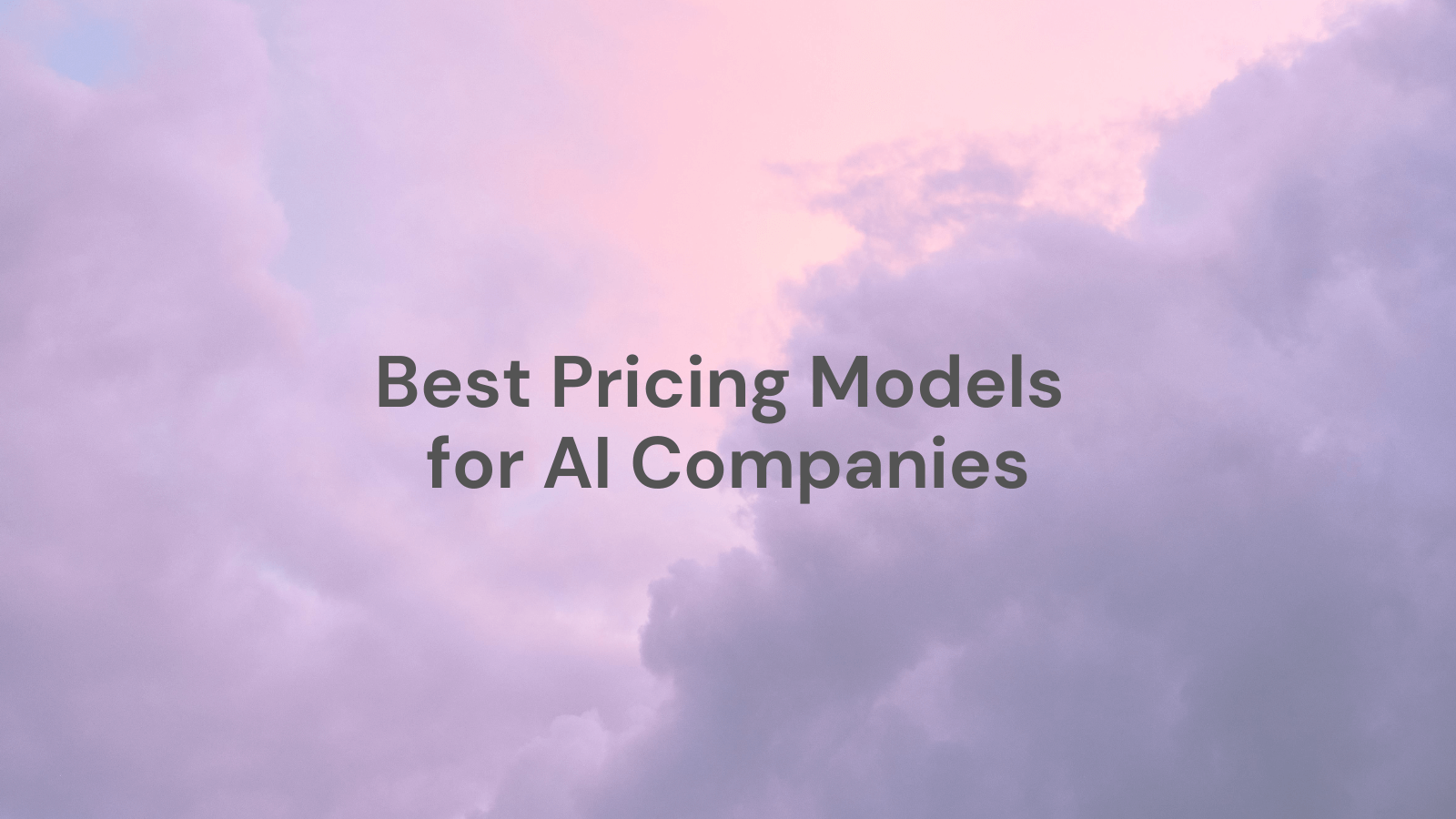20 Pricing Strategies for AI-Native B2B Startups from Atlas
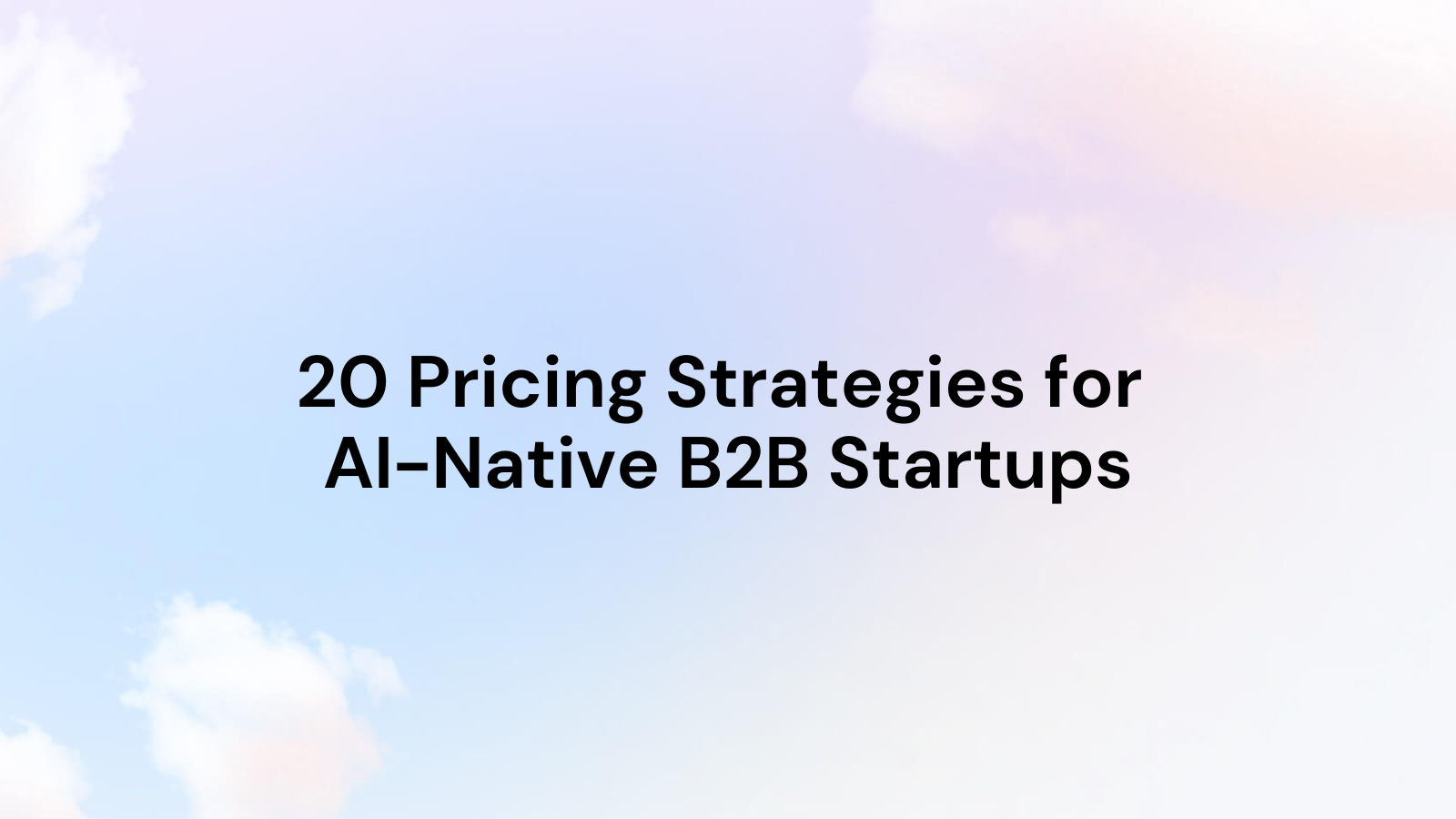
Why This Guide?
AI-native startups have the potential to tackle billion‑dollar problems, but all too often they crash and burn on a “$19/month” pricing model. Why does this happen? Because the classic SaaS pricing playbook simply doesn’t map to AI‑powered businesses. You’re not just delivering lines of code or a simple feature set, you’re delivering:
- Usage‑Based Compute Costs
- Your infrastructure bills scale with every model call, training run, or data transformation. A flat fee can quickly become a loss leader.
- Dual Value Drivers: Seats & Outputs
- In traditional SaaS, you charge per user. In AI, you must account both for the humans who log in and the value generated by each model inference or data insight.
- Intelligent Automations That Replace Human Labor
- When your product saves dozens of hours (or even entire FTEs), a $19/month plan wildly underprices the value you deliver.
- “Magic” Expectations
- Your customers aren’t just buying software—they expect seemingly magical speed, accuracy, and ease. Price tiers must align with levels of sophistication, SLAs, and support.
To thrive in this new landscape, you need pricing that’s smart, dynamic, and perfectly aligned with the value you deliver to each customer.
Who We Are: Atlas
At Atlas, we’re on a mission to empower the next generation of AI‑native startups. Our platform provides pricing, packaging, and billing engines purpose‑built for AI businesses, handling everything from metered model usage to complex revenue recognition and flexible packaging.
We remove the heavy lifting so you can focus on building transformative AI products and scaling with confidence.
In the pages that follow, you’ll discover 20 pricing strategies designed specifically for AI‑powered B2B startups, strategies that will help you charge what you’re worth, manage costs, and capture the full upside of your AI innovation. Let’s dive in.
Try Atlas for Free or Book a demo with the founders
1. "Magic Button" Pricing
Flat fee for one specific high-impact outcome
Example: “Audit all your PDFs for $99”
This strategy distills your product down to a single, high-value transformation—packaged as a one-click solution with a clear before/after. It’s like selling a result, not a tool. Perfect for AI products that feel like “magic,” it removes decision friction and is especially powerful in onboarding flows, landing pages, and paid acquisition funnels.
- Great for onboarding – Customers get instant value and understand what your AI can do, not just what it is.
- Easy to bundle later into subscription – Once trust is built, upselling into ongoing usage becomes natural.
Real-World Example: AuditBot
AuditBot is an AI-powered audit automation platform that offers a flat fee per audit—a model that fits squarely into “Magic Button” pricing:
- They charge £950 per audit, regardless of complexity or client size—no monthly subscription, just a one‑time payment for a complete AI‑driven audit.
- You're paying for a single, high-value deliverable: an entire audit report generated in a fraction of the traditional time.
- It's simple, frictionless, and easy to market as “Run one audit. Pay once. See results instantly.”
This model excels in onboarding and paid acquisition—users try one audit, experience the value, and can later be upsold into ongoing monitoring or a subscription plan if available.
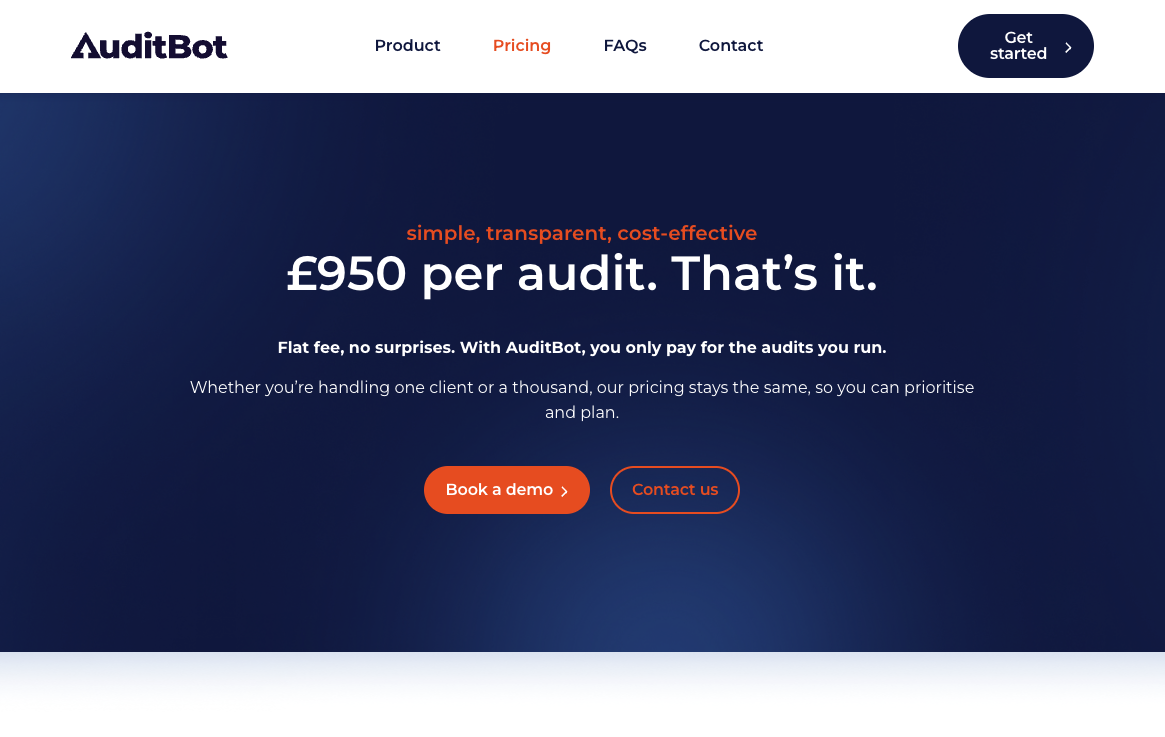
2. Founder's Seat Free
First user free, team seats paid (e.g., $0 → $19/user/month)
This strategy gives solo users—especially founders, team leads, or decision-makers—free access to explore your product without any commitment. Once they see the value, inviting collaborators or their team naturally triggers a per-seat pricing model. It's a powerful wedge that removes friction upfront and bakes in expansion as the next logical step.
- Low-friction entry – No credit card, no blockers. Just value, fast.
- Works well when founders explore tools solo – Many AI tools are initially tested by technical or strategic leads before being rolled out to teams.
Real-World Example: Gamma.app
Gamma, an AI-powered slide and doc generator, lets the first user explore, generate content, and even publish without paying. But as soon as you invite collaborators, comment in threads, or share across teams, you hit soft walls that prompt an upgrade per additional user. It’s founder-friendly upfront, yet clearly team-focused in monetization—capturing solo curiosity while setting the stage for team growth.

3. Output Pack Credits
$49 = 100 AI-generated [contracts, audits, ideas, charts]
This model sells discrete outcomes in the form of credit packs—each credit representing a single AI-generated deliverable. It works beautifully when your product produces tangible, repeatable outputs, like contracts, reports, or creative assets. You avoid the confusion of subscription tiers and instead align pricing with exact value delivered.
- Credits = scalable unit of value – Easy to understand, purchase, and track. Customers only pay for what they use.
- Expiry optional to drive urgency – Add a time limit (e.g., 30 days) to encourage usage and repeat purchases.
Real-World Example: Jasper AI
Jasper originally launched with credit-based pricing tied to the number of AI-generated words. A $49 plan might give you 50,000 words, which you could spend on blog posts, emails, or ads. This made AI feel tangible and helped users associate specific pricing with specific outputs. As usage matured, Jasper transitioned users to monthly subscriptions—but credits helped establish perceived value from day one.
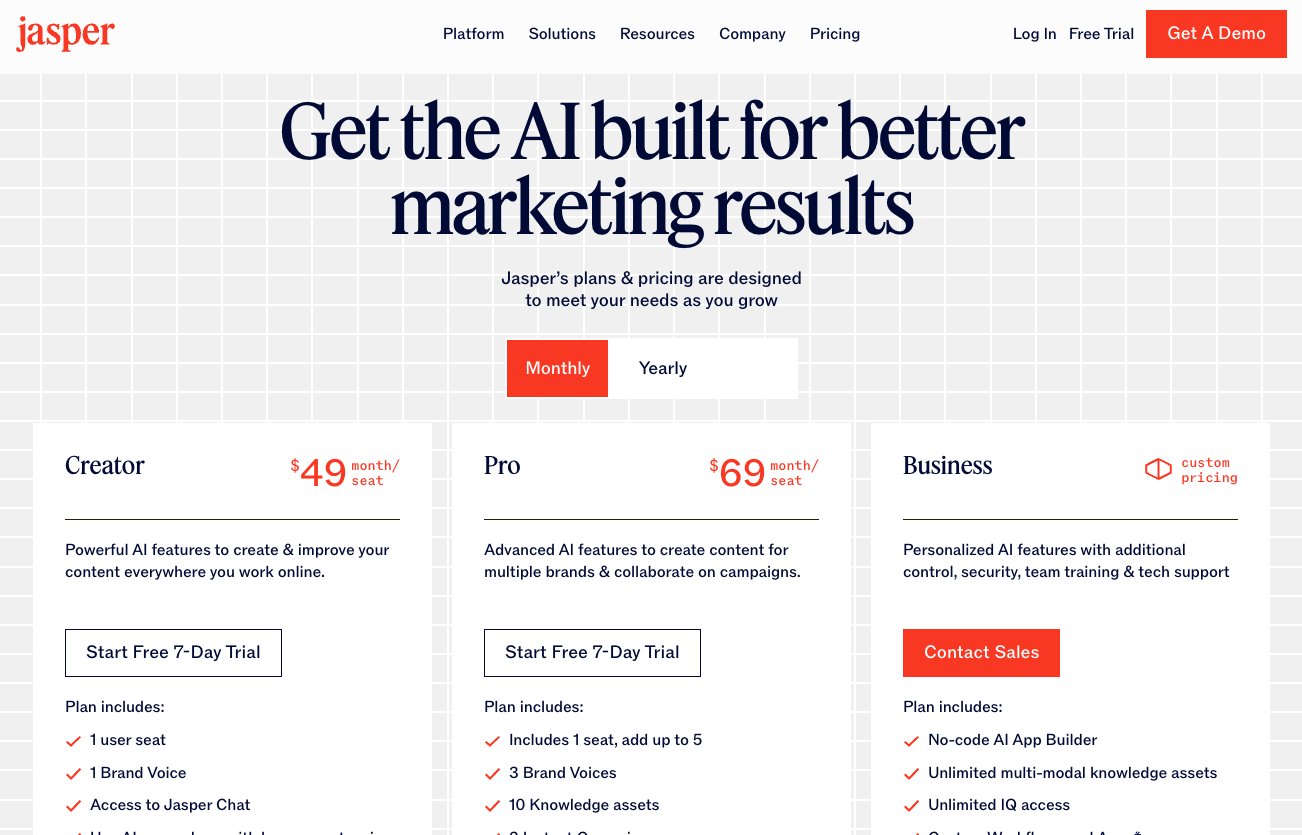
4. Premium Model w/ AI Overlays
Core SaaS is free → AI-powered workflows unlock at $49+
This strategy builds on the traditional freemium model, but with a twist: the AI features are the premium upsell. You give away the base product (e.g., a workspace, dashboard, or toolkit) and charge only when users want to unlock time-saving, intelligence-driven workflows. It’s effective because the AI layer is clearly differentiated and highly valued, making the upgrade feel worth it.
- Good for converting free users – Users can build familiarity before hitting the “AI paywall.”
- AI = clearly valuable upsell – The AI features are positioned as powerful upgrades, not just minor enhancements.
Real-World Example: Notion AI
Notion offers its full workspace product for free with generous usage limits. But if you want to generate summaries, auto-complete tasks, brainstorm ideas, or ask questions using Notion AI, you’ll need to pay $8–$10/month per user. The AI isn’t bundled by default—it’s a premium overlay. That distinction makes it easy to upsell existing users who already love the product and want to work faster.
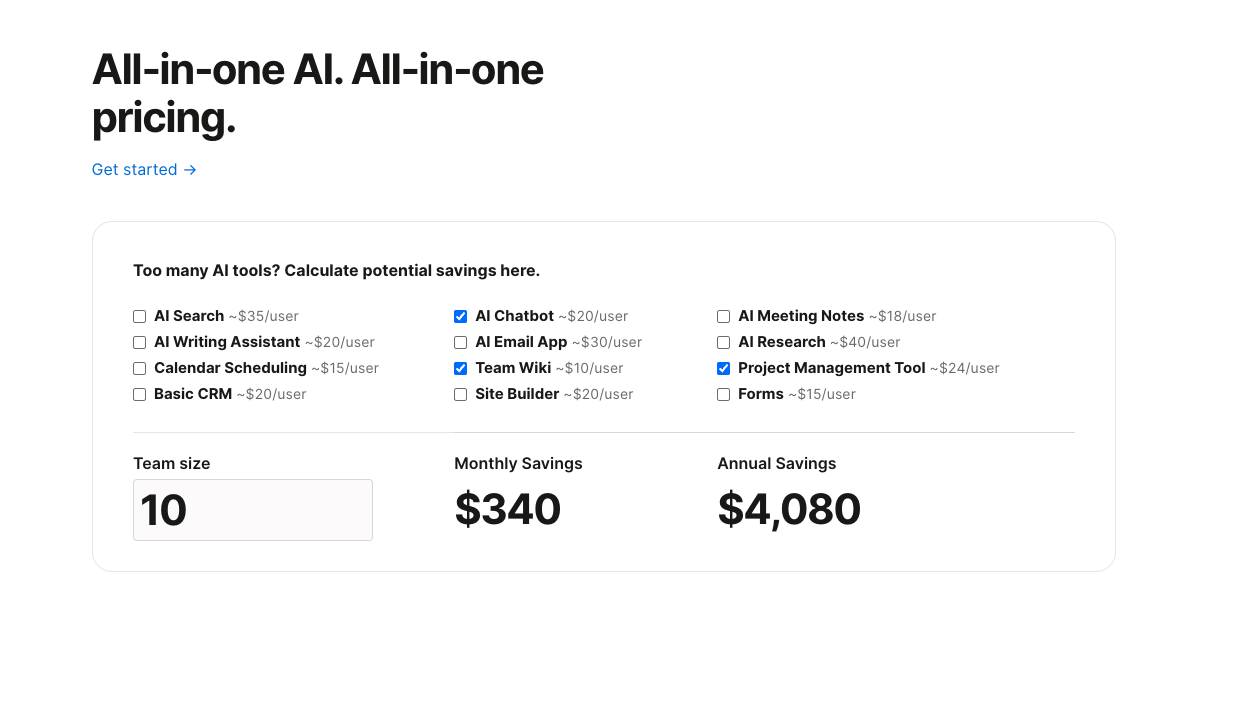
5. Reverse Trials
Start with everything unlocked for 7 days → downgrade unless they convert
Instead of locking users out of premium features and hoping they upgrade, reverse trials flip the funnel: give full access from day one, then remove advanced features after a short trial (e.g., 7 or 14 days). This creates a powerful “fear of loss” dynamic—users experience the full magic, integrate your AI into their workflows, and then feel the downgrade.
- Pulls users into premium features by default – No need to “sell” the upgrade—users already know the value.
- Great for productivity & ops AI tools – Works well when your AI enhances day-to-day tasks and gets embedded into habits quickly.
Real-World Example: Motion
Motion, an AI scheduling and project management tool, gives new users full access to its smart calendars, task prioritization, and automation features during a 7-day free trial. After the trial ends, users are downgraded to a limited version unless they upgrade. Because the AI deeply integrates into daily routines during that week, many users feel the pain of losing it—and convert.
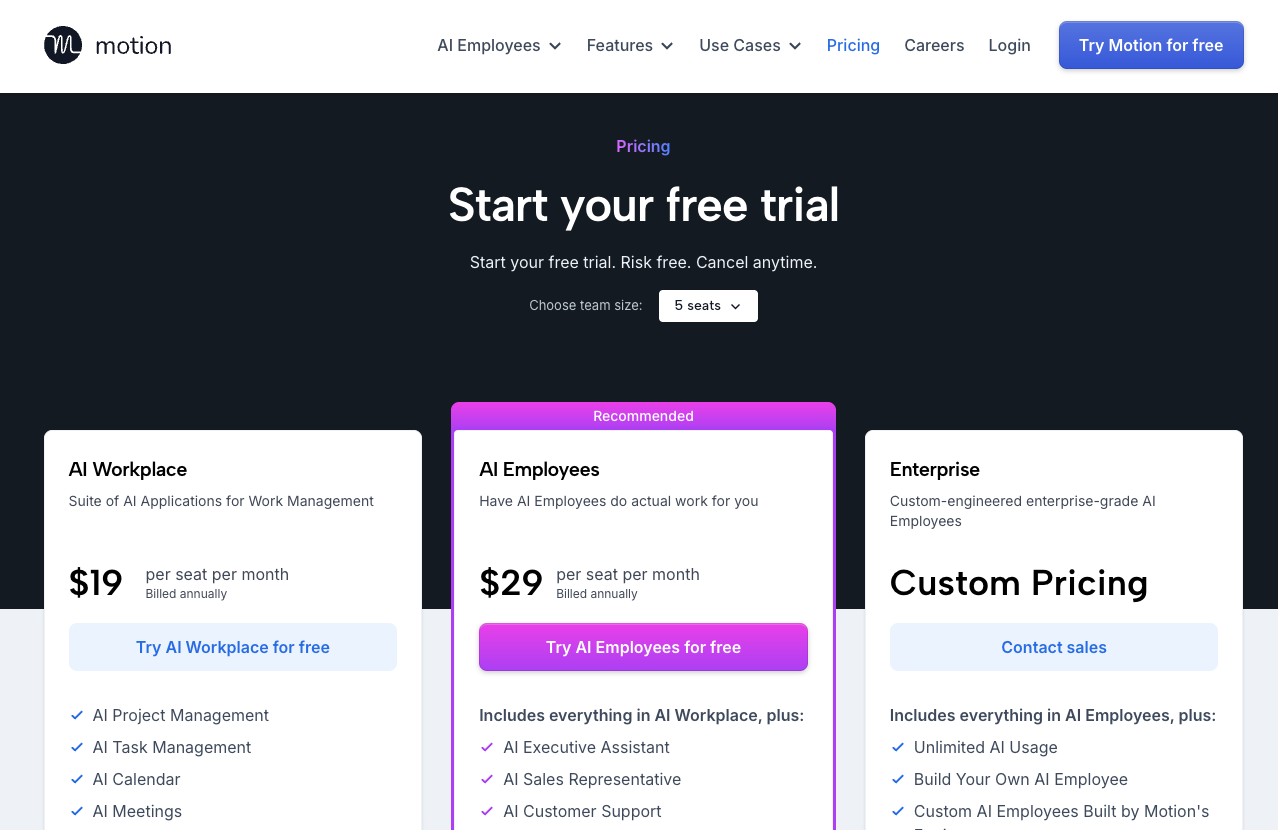
6. Per Workflow Automation
$XX/month per active AI workflow (e.g., auto-check email threads for risk)
This strategy charges based on the number of unique AI workflows a customer activates—think of it as pricing for automation logic, not usage volume. Ideal for products that embed AI into operational flows (like document parsing, email triage, or customer support tagging), it aligns pricing with depth of integration, not just surface-level usage.
- Makes sense for AI integrations – Works well when customers build and deploy custom workflows using modular blocks or no-code interfaces.
- Encourages depth of use – Customers get more value as they build more automations, leading to higher retention and expansion.
Real‑World Example: n8n
n8n is a fair-code, open-source automation platform that lets users build custom workflows using a no-code/low-code interface—similar to Zapier, but highly extensible for developers and teams that want more flexibility and control.
For their cloud-hosted product, n8n’s pricing scales based on the number of active workflows and executions, especially in the Faircode (business) edition:
- Plans start at $20/month and scale up depending on the number of workflows you run concurrently and how often they’re triggered.
- They define workflows as modular automation chains—e.g., “Monitor new leads from CRM and trigger a Slack alert” or “Parse emails for invoice data and send to accounting.”
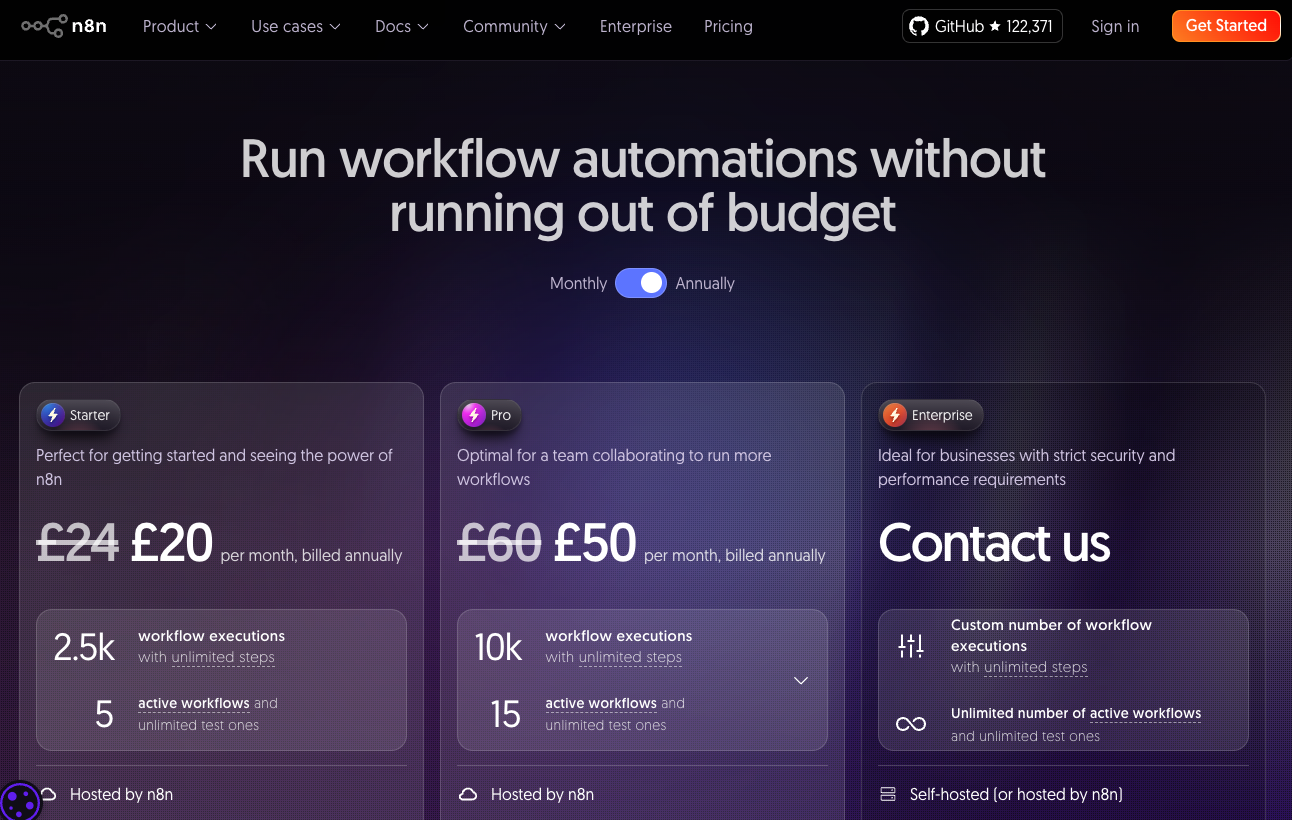
7. Audit-to-Recurring Play
$99 for one-time AI analysis → $49/month for ongoing monitoring
This strategy starts with a high-value, one-off AI audit that diagnoses a key pain point, security, compliance, SEO, financial health, etc. Once users see the insights (and risks) revealed by your AI, you upsell them into a recurring plan for continuous tracking, alerts, or updates. It’s a classic land-and-expand model designed for fast conversion to MRR.
- Easy proof of value – A low-risk, fixed-price audit builds immediate trust and shows what your AI can do.
- Converts to MRR – Ongoing value (e.g., monitoring, reporting, automated follow-ups) makes the monthly fee a no-brainer.
Real-World Example: Secureframe
Secureframe offers AI-assisted compliance tools. Many startups begin with a one-time SOC 2 readiness assessment, essentially a structured and automated audit. Once complete, Secureframe nudges customers into a recurring plan for continuous compliance monitoring, evidence collection, and reporting. The initial audit proves the need, and the ongoing plan solves it.
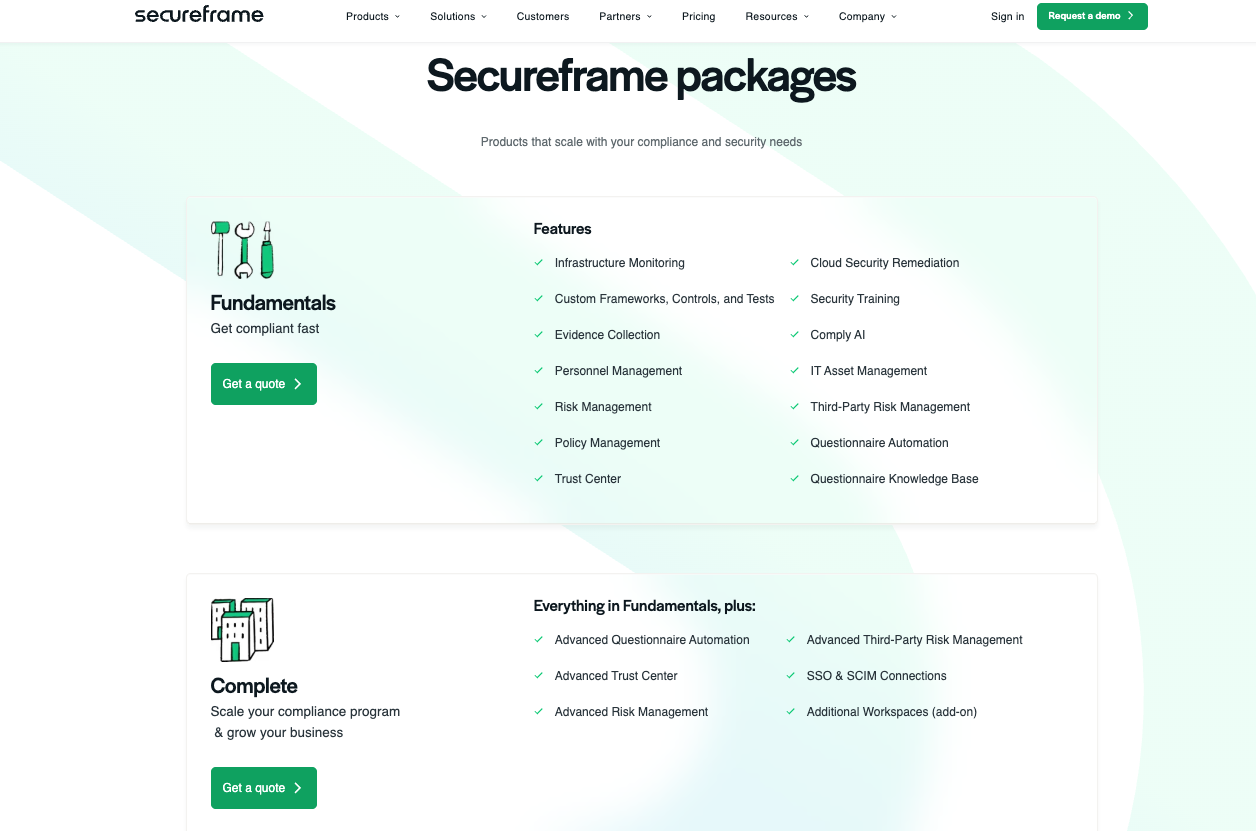
8. Seats + Compute Hybrid
$20/seat + $X per 1,000 AI requests (OpenAI-style)
This hybrid pricing combines a fixed per-user fee with a variable charge based on AI compute usage—usually measured in API calls, tokens, or model inferences. It’s highly transparent and aligns costs with both the number of users and the intensity of AI consumption, making it a natural fit for tech-savvy buyers who want to see exactly what they’re paying for.
- Transparent for tech buyers – Clear breakdown of fixed and variable costs helps customers understand and forecast expenses.
- Map value to cost – As usage (and value) grows, the pricing scales fairly without surprises.
Real-World Example: OpenAI
OpenAI’s pricing combines a flat monthly fee for platform access (e.g., developer account or seats) with a pay-as-you-go model charging per 1,000 tokens processed by GPT or other models. This ensures both accessibility for smaller teams and proportional pricing for heavy users, balancing fairness and scalability.
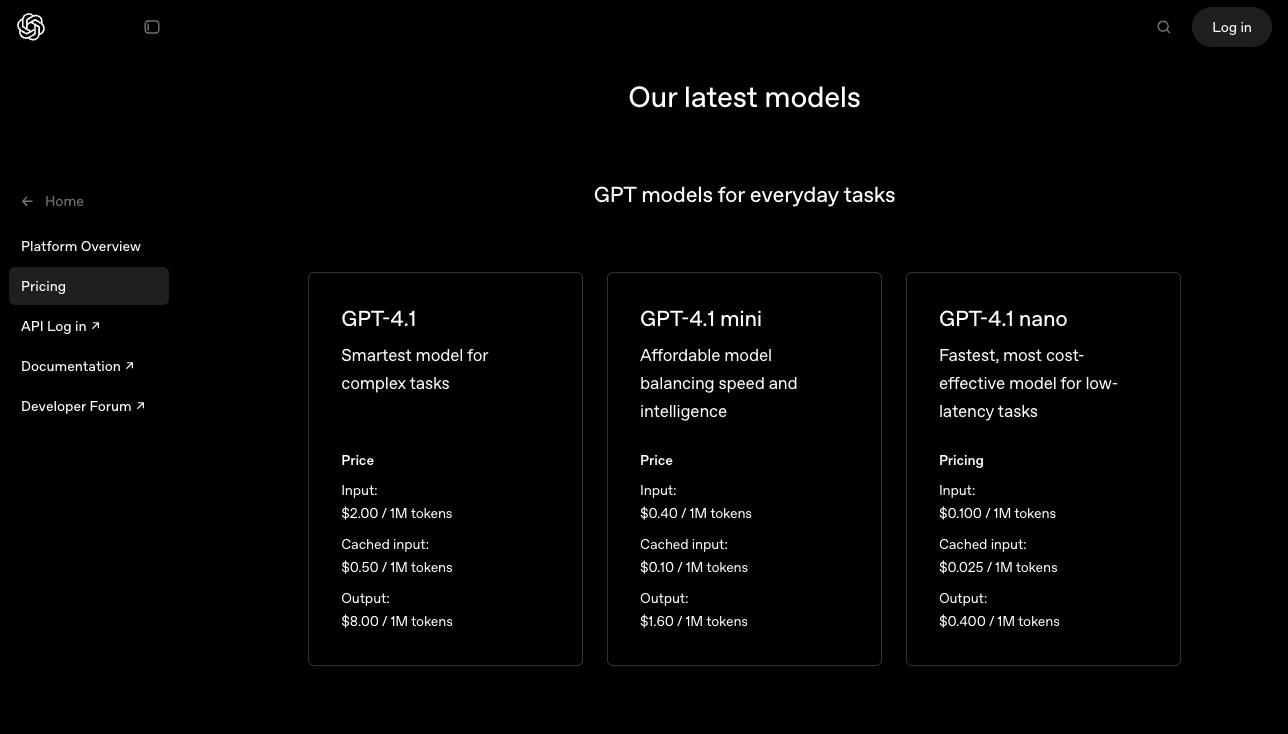
9. Data Ingestion Tiering
Pricing based on rows, files, or gigabytes of data processed
This strategy charges customers according to the volume of data they feed into your AI system—whether that’s the number of rows ingested, files uploaded, or total gigabytes processed. It directly ties pricing to the scale of customer operations, making it especially attractive for enterprise clients with large datasets.
- Scales well with enterprise usage – As companies grow their data footprint, your revenue grows proportionally.
- Harder to fake value – Unlike feature-based tiers, data volume is a straightforward, objective metric that’s difficult to game or justify.
Real-World Example: Fivetran
Fivetran, a data pipeline and ingestion platform, bills customers based on the number of rows processed monthly. This clear, usage-based pricing scales naturally with customer growth and avoids ambiguity about what you’re paying for. It’s a model well-suited to data-heavy AI startups offering ingestion, ETL, or analytics services.

Want to simplify your pricing stack while deploying complex AI-native strategies?
Atlas lets you build tiered plans, usage billing, and custom pricing flows — no code, no hacks.
Try Atlas free or book a demo with the founders
10. Tiered Paywalls on AI Models
GPT-3.5 = Free → GPT-4 = $99/month
This approach offers basic AI models or capabilities for free or a low cost, while gating access to more advanced, powerful models behind a premium tier. It works especially well for AI copilots, assistants, or platforms where users can start with basic features and upgrade as they need greater accuracy, speed, or sophistication.
- Works great for AI copilots or assistants – Users can try helpful, lower-tier AI without commitment, then pay for premium “brainpower.”
- Let users grow into cost – Start simple and low-cost; upsell when users demand higher performance or features.
Real-World Example: OpenAI
OpenAI’s ChatGPT offers free access to GPT-3.5, with GPT-4 reserved for paid subscribers. This tiered access encourages broad adoption and gives users a clear upgrade path as their needs—and willingness to pay—increase.
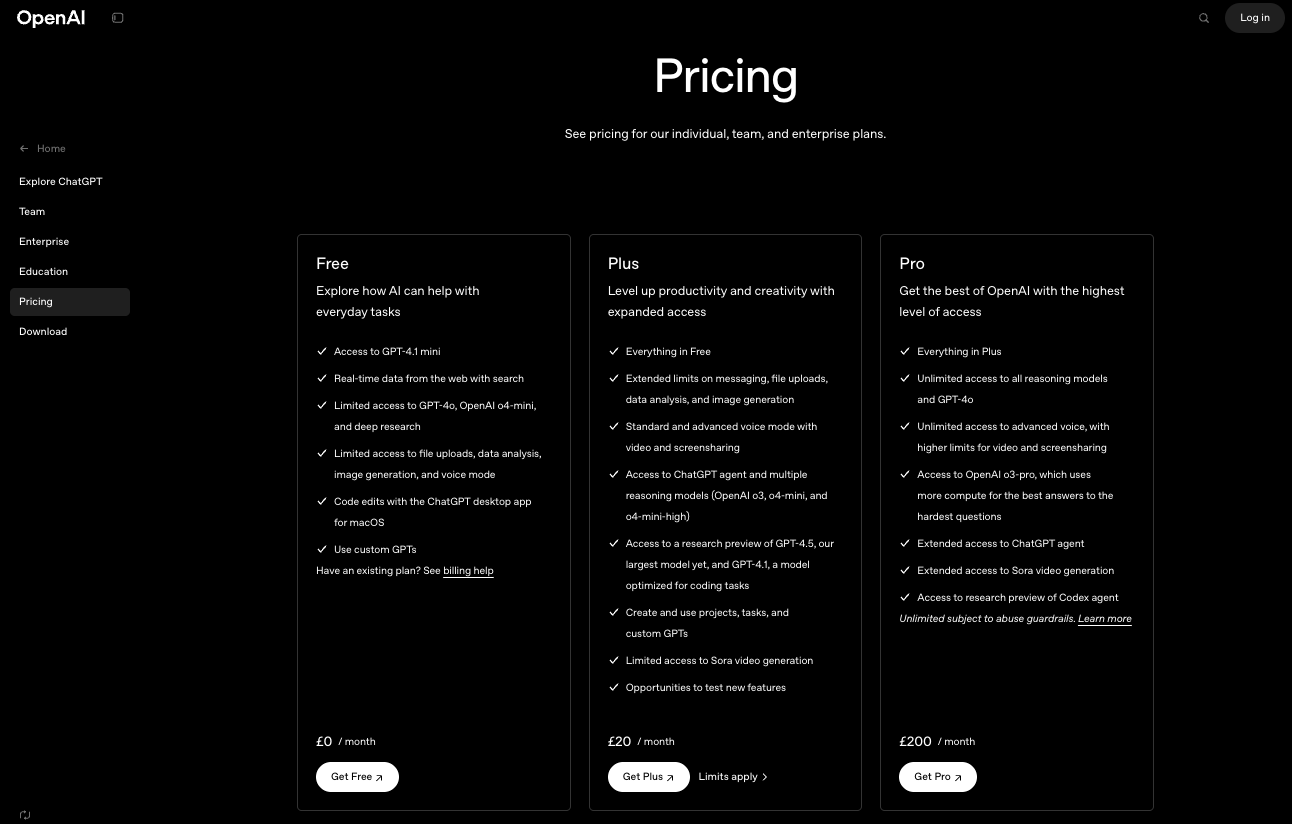
11. "Role-Based" Pricing
Different pricing tiers for distinct user roles—e.g., $X for marketers, $Y for analysts—all within the same product
This strategy segments pricing based on the specific function or role of the user, tailoring features and pricing to the unique needs of each group. It’s ideal when your AI product serves multiple departments with varying usage patterns, value perceptions, or budget ownership.
- Bundle by function – Customize feature sets and price points that make sense for each role, improving user satisfaction and adoption.
- Lets you tap multiple budgets – By appealing to different departments (marketing, finance, ops), you increase your chances of expanding across the organization.
Real-World Example: Figma
Figma is a collaborative design platform used by designers, developers, marketers, and product teams. Its pricing strategy includes:
- Editors (paid): Users who can create, edit, and comment on designs or prototypes. These are typically designers, product managers, or developers who need hands-on access.
- Viewers (free): Users who can view and comment but can’t edit. These are often stakeholders like marketers, execs, or clients.
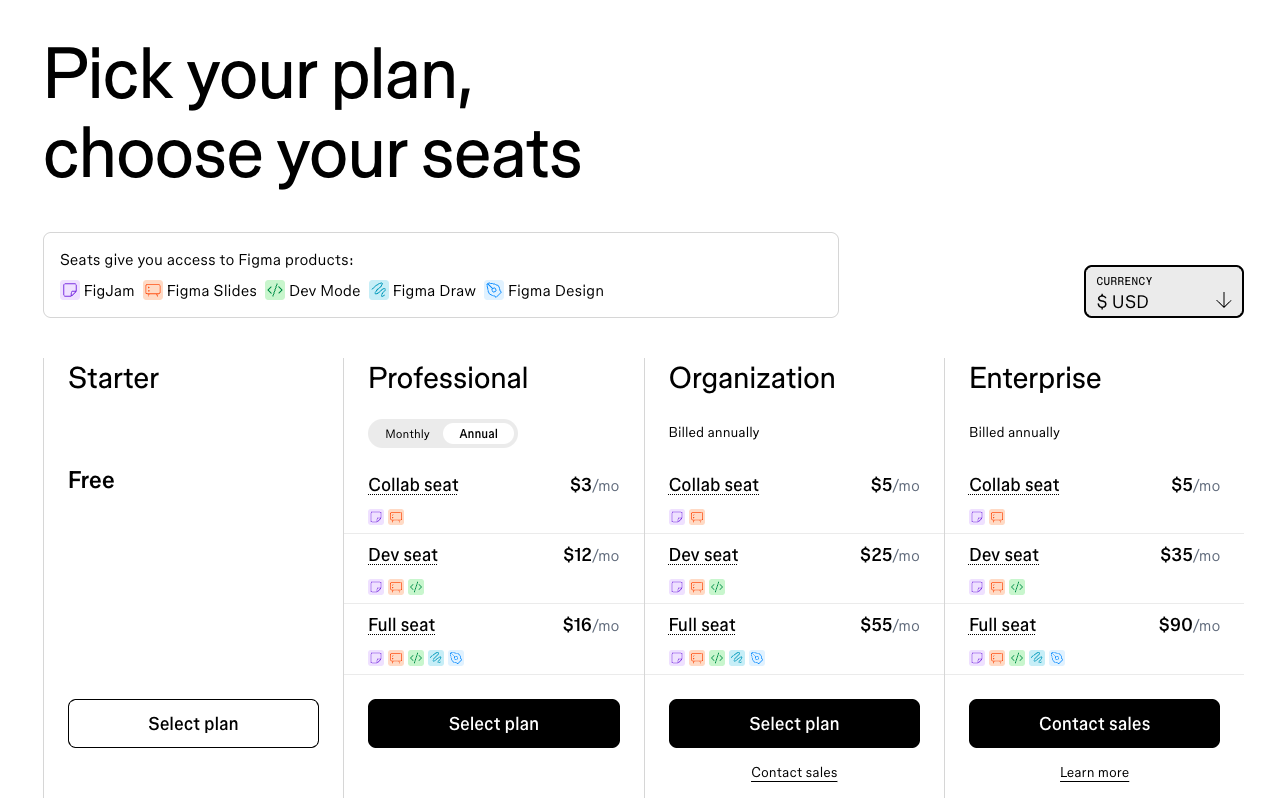
12. Event-Based Pricing
Charge per API call, task run, or scheduled scan
This model bills customers based on each discrete event triggered within your AI system, such as API requests, automated tasks executed, or scheduled data scans. It directly correlates pricing with the intensity of product usage and infrastructure costs, making it highly transparent and scalable.
- Aligns to actual infrastructure usage – Customers pay in proportion to the compute or operations they consume.
- Needs clear value-per-call – To avoid sticker shock, users must understand the value delivered by each event.
Real-World Example: Algolia
Algolia, a search-as-a-service platform, charges based on the number of search requests (API calls). Each query corresponds to an event, and customers pay more as usage increases. This keeps pricing fair and tied to customer scale, while clearly communicating the value per request.
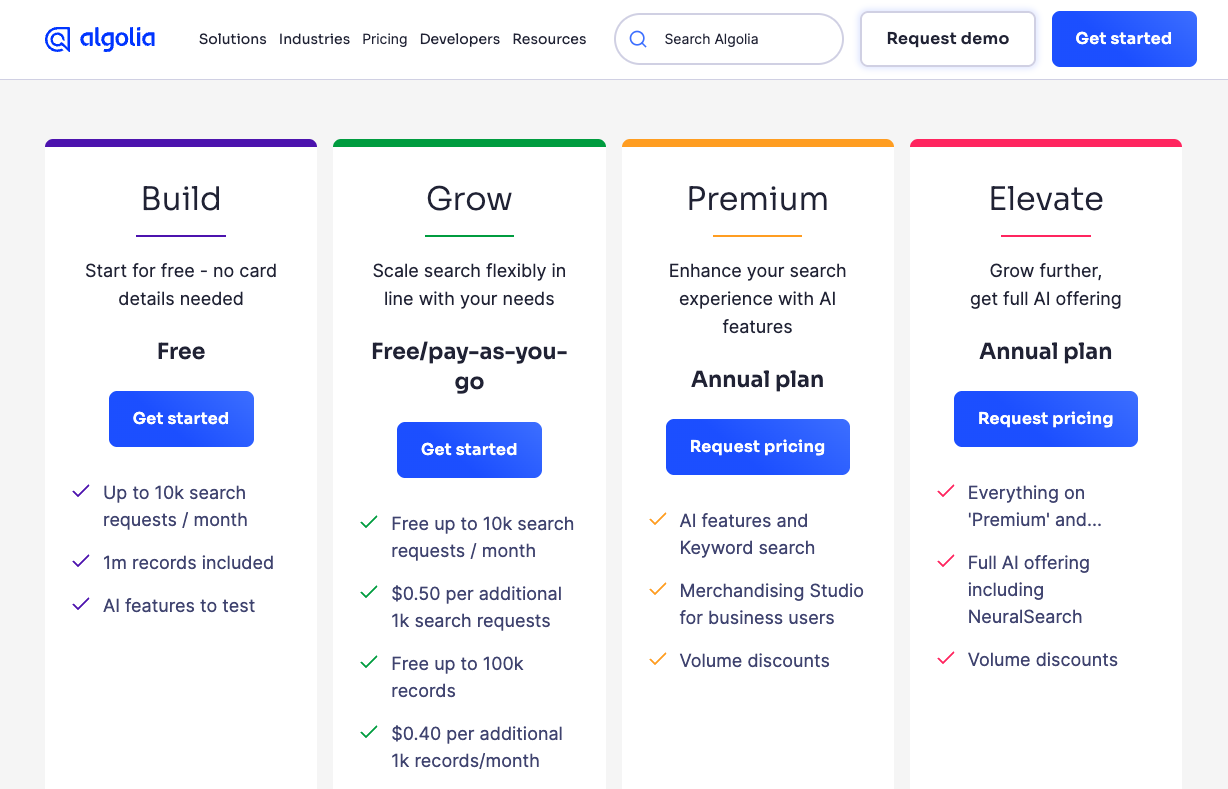
13. AI Concierge Tiers
Starter = DIY, Pro = AI does it for you
This pricing approach distinguishes between customers who prefer a do-it-yourself (DIY) experience and those who want the AI to handle everything autonomously. The starter tier provides tools and guidance, while the premium “concierge” tier lets the AI take over the entire process—delivering high-touch, done-for-you outcomes.
- Framing = powerful positioning – Shifts perception from “software” to “service,” highlighting ease and time saved.
- Messaging tip: Use phrases like “Let AI take over” or “Sit back and watch the AI work for you.”
Real-World Example: Copy ai
Copy ai offers a self-serve plan where users craft their own copy using AI templates and tools, but their higher-tier plans include advanced automation features and priority support, effectively acting as an AI-powered copywriting concierge. The premium tier appeals to customers who want to offload the creative workload.
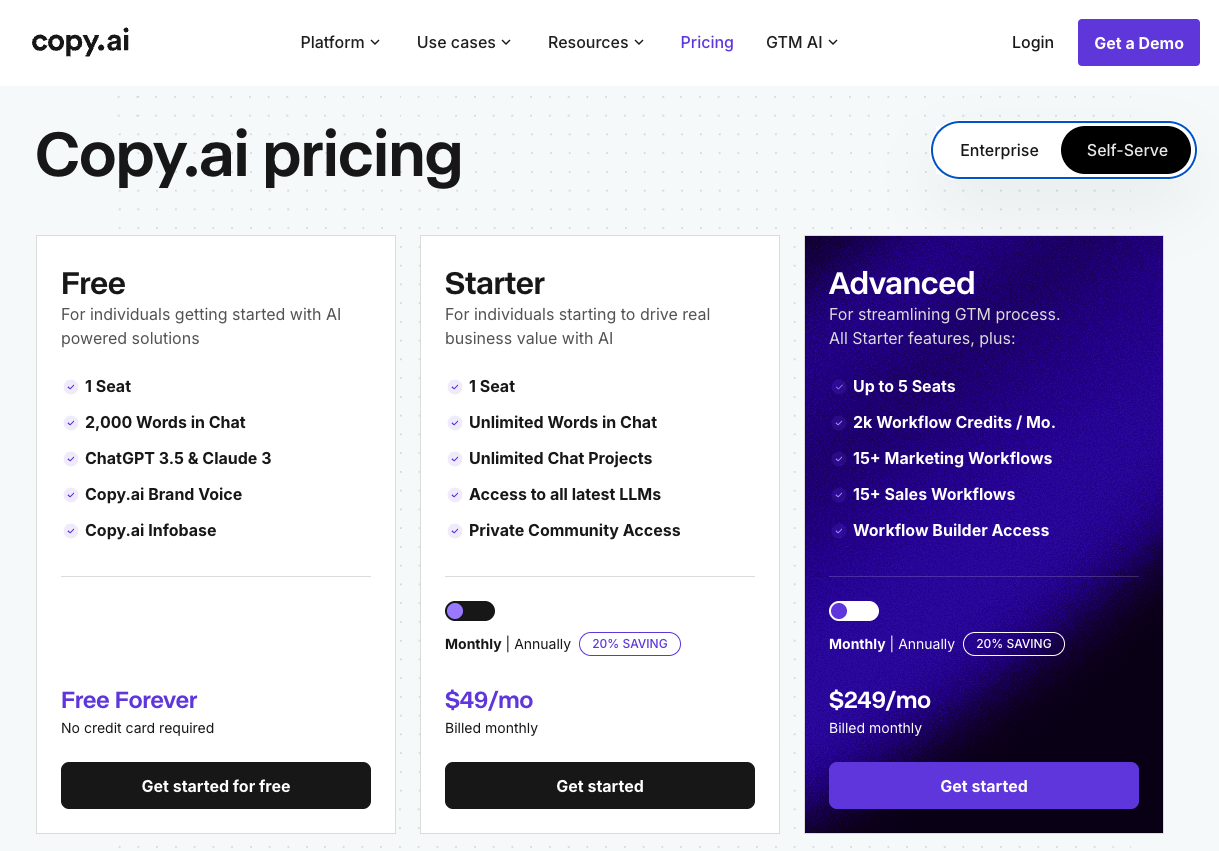
14. "No Code" Add-on Pricing
AI API = $49/month
GUI builder = +$30/month
This pricing splits the product into a core AI API for developers and a no-code GUI builder as an add-on for non-technical users. It allows lean developer teams to pay just for the backend intelligence, while offering an upsell to teams that want an easy visual interface for building workflows or apps without code.
- Developers stay lean, teams upgrade – Keeps costs low for technical users but unlocks broader adoption by empowering non-developers.
- Let teams pay for ease – Customers happily pay a premium for simplified interfaces that speed up deployment and reduce reliance on engineers
Real-World Example: DumplingAI
DumplingAI offers two core offerings that reflect the structure of “No-Code Add‑On Pricing”:
- API‑only Plan — $49/month for developers who want access to all AI APIs and 10,000 credits, without bundled marketing tools.
- Pro & Business Plans — From $124/month and up, which include the AI Content Marketing Platform**—a no-code GUI for content creation layered on top of the APIs.
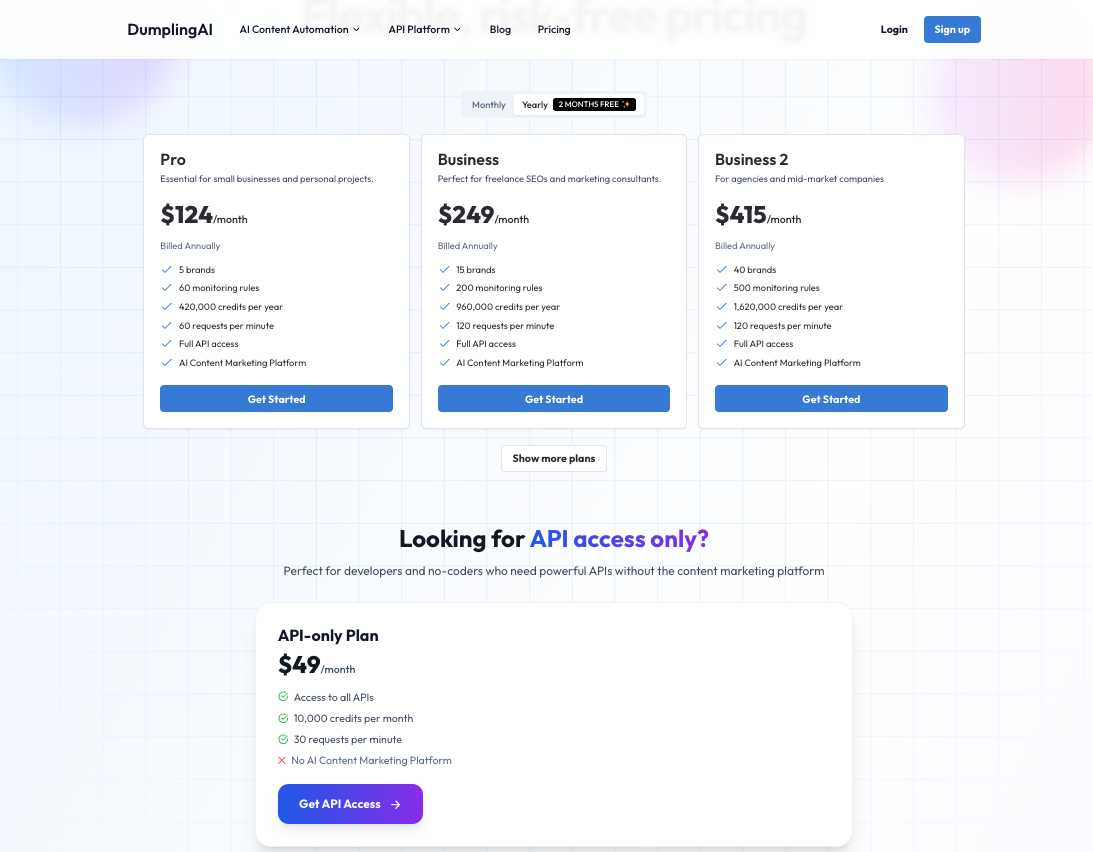
15. Industry-Specific Plans
LegalGPT, FinGPT, SalesGPT: separate value props and price points
This strategy creates distinct plans tailored to different industries or verticals, each with specialized AI features, workflows, and pricing aligned to that market’s unique needs. By customizing the product experience, you can address specific pain points more deeply and command premium pricing.
- Hyper-targeted messaging – Speak directly to industry challenges and decision-makers with relevant benefits.
- Increases perceived value – Tailored solutions feel more valuable and justify higher price points.
Real-World Example: Drata
Drata offers tailored compliance automation solutions for industries like SaaS, finance, and healthcare. Each vertical plan highlights specific features and workflows relevant to that sector, helping customers see clear, industry-specific ROI.
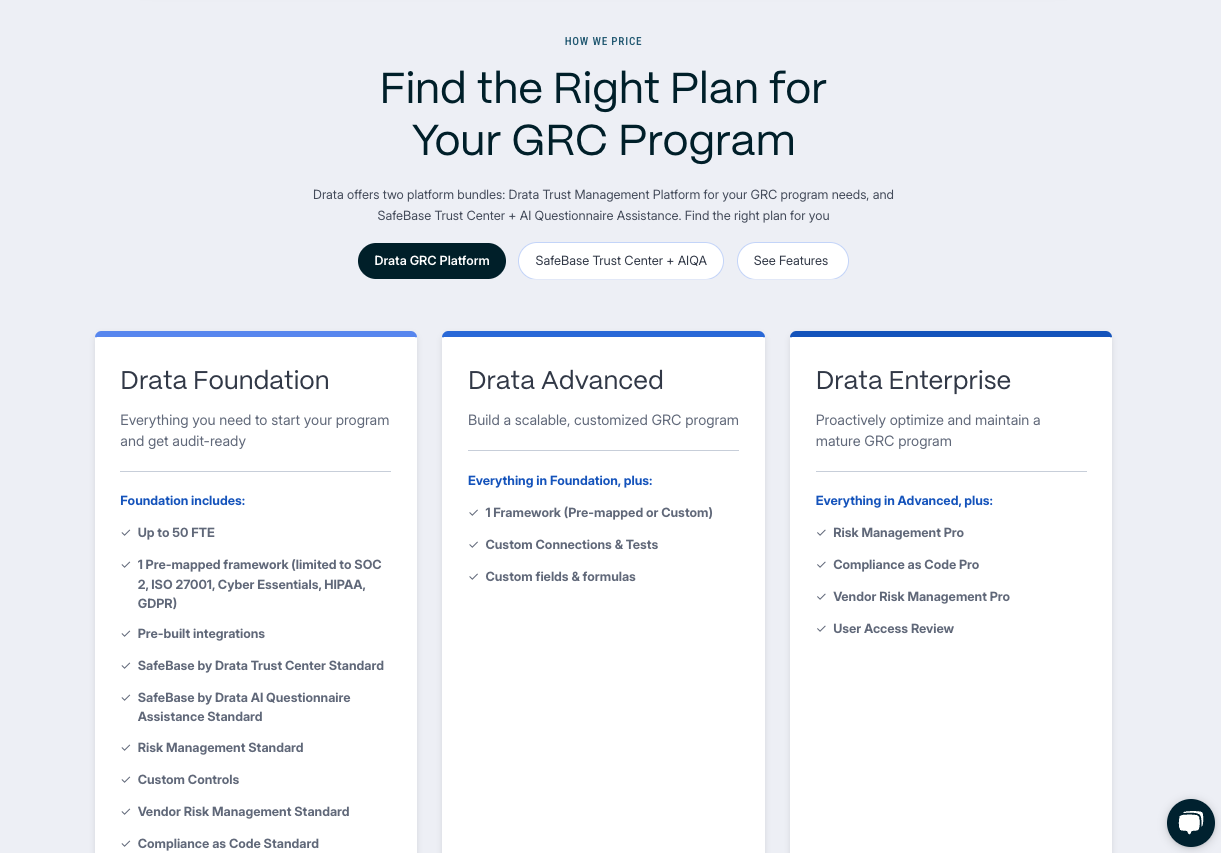
16. Outcome-Based Retainers
AI assistant helps your team book 10 demos/month = $X
This pricing model charges customers a fixed retainer fee based on a guaranteed outcome or key performance indicator for example, your AI-driven assistant delivers 10 qualified demos per month, and you get paid accordingly. It’s a high-trust, high-stakes agreement that ties your revenue directly to your product’s impact.
- High trust model – Builds deep customer relationships grounded in shared success and accountability.
- Only if you can guarantee results – Requires strong confidence in your AI’s performance and clear, measurable metrics.
Real-World Example: Intercom + Fin AI Agent
Intercom’s AI agent, Fin, launched in 2023 offering outcome-based pricing where customers are billed $0.99 per successful support resolution—only when the AI completes a conversation successfully. If the conversation remains unresolved—or requires human escalation—there’s no charge the ai opportunities.
This structure creates a pay-for-performance model that aligns incentives: customers only pay when the AI delivers real outcome (resolved tickets), and Intercom is motivated to continually improve effectiveness.
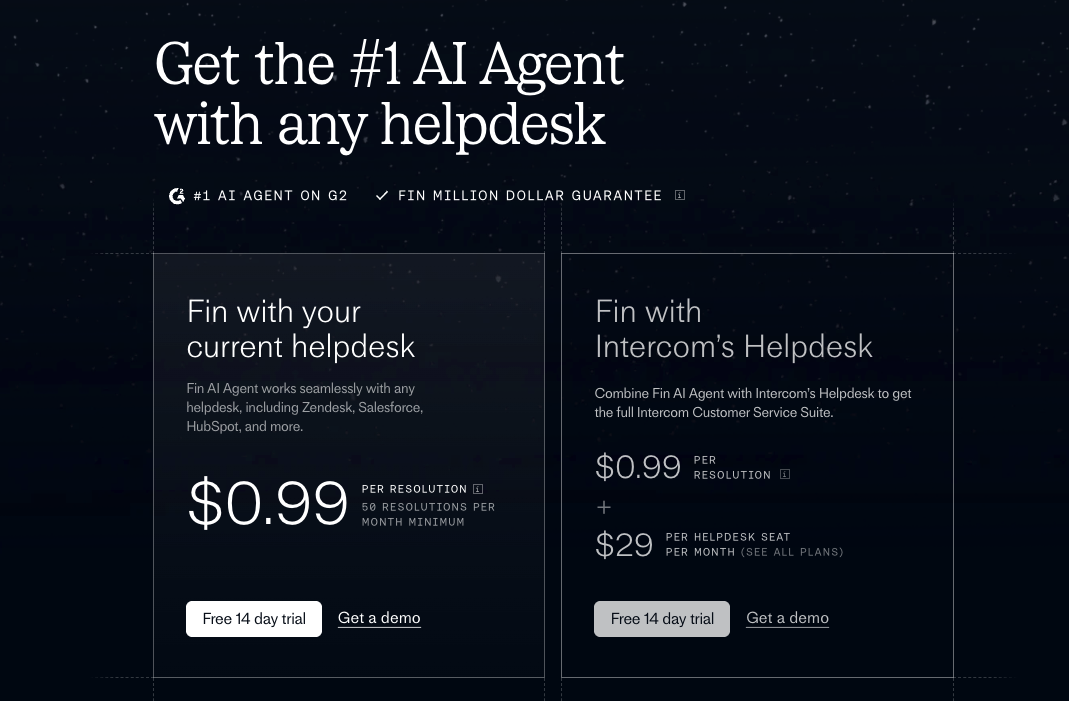
17. Open Source Core + Paid Hosted AI
Open-source framework = free
AI-powered dashboards, managed deployments = $99+/month
This hybrid pricing model offers a free open-source core that developers can use and customize themselves, while charging for hosted, managed AI services and premium features like dashboards, monitoring, and automatic updates. It leverages community adoption to build trust and then monetizes convenience and scale.
- Dev audience loves this – Appeals to technical users who want control and flexibility without upfront cost.
- Sell convenience & scale – Customers pay for hassle-free hosting, reliability, and additional AI-powered tools.
Real-World Example: Supabase
Supabase is an open-source backend-as-a-service platform that offers free core tools but charges for hosted databases, analytics, and enterprise features. This balance between free code and paid services drives adoption while building a sustainable business.

18. Smart Expansion Metrics
Users scale automatically from:
- 100 docs → 500 → 5,000
- 1 brand → 5 brands
This strategy ties pricing growth to natural expansion metrics within the customer’s usage, such as document count, number of brands managed, or other scalable units. As customers deepen their usage and reliance on your AI product, their subscription tiers and monthly recurring revenue (MRR) increase automatically.
- Usage-based MRR – Your revenue grows proportionally with customer expansion, aligning pricing with value delivered.
- Reduces churn – Customers stay longer because their pricing grows organically with their success, not through abrupt increases.
Real-World Example: Canva
Canva’s pricing increases as teams add more users, storage, or premium features, allowing customers to grow into higher tiers without feeling forced naturally.
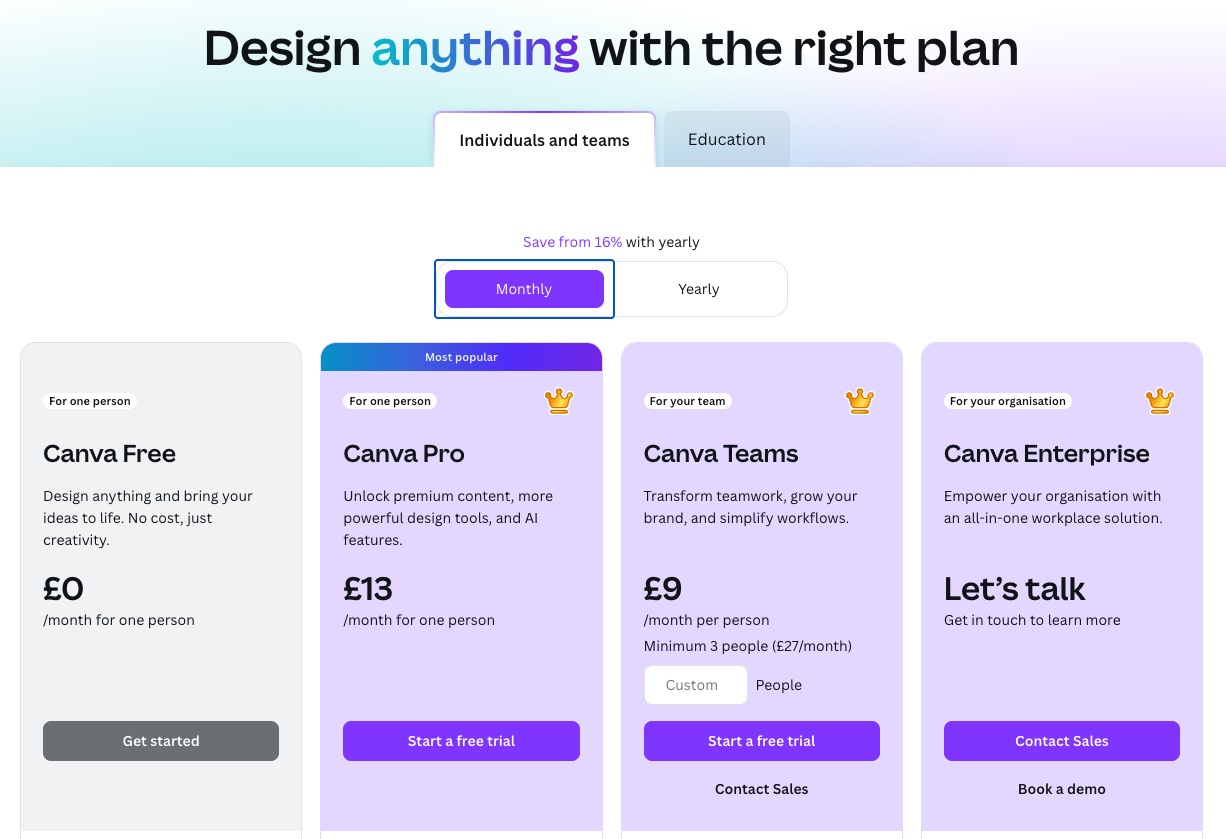
19. Pay As You Grow AI
$X base → auto-scale as usage grows (with warning alerts)
This pricing model starts with a base fee and automatically scales pricing in line with customer usage, similar to cloud providers like AWS. Crucially, it includes advance warnings or alerts when customers approach higher usage thresholds, giving them transparency and control over costs.
- AWS-style AI pricing – Customers pay precisely for what they use, encouraging efficient consumption without upfront commitments.
- Peace of mind = less buyer anxiety – Proactive alerts reduce bill shock and build trust, making it easier for customers to adopt your AI.
Real-World Example: Amazon Web Services (AWS)
AWS charges a low base fee for many services but scales with compute, storage, or API usage. Their detailed billing and notification system helps customers stay informed and in control, fostering confidence in scaling usage.
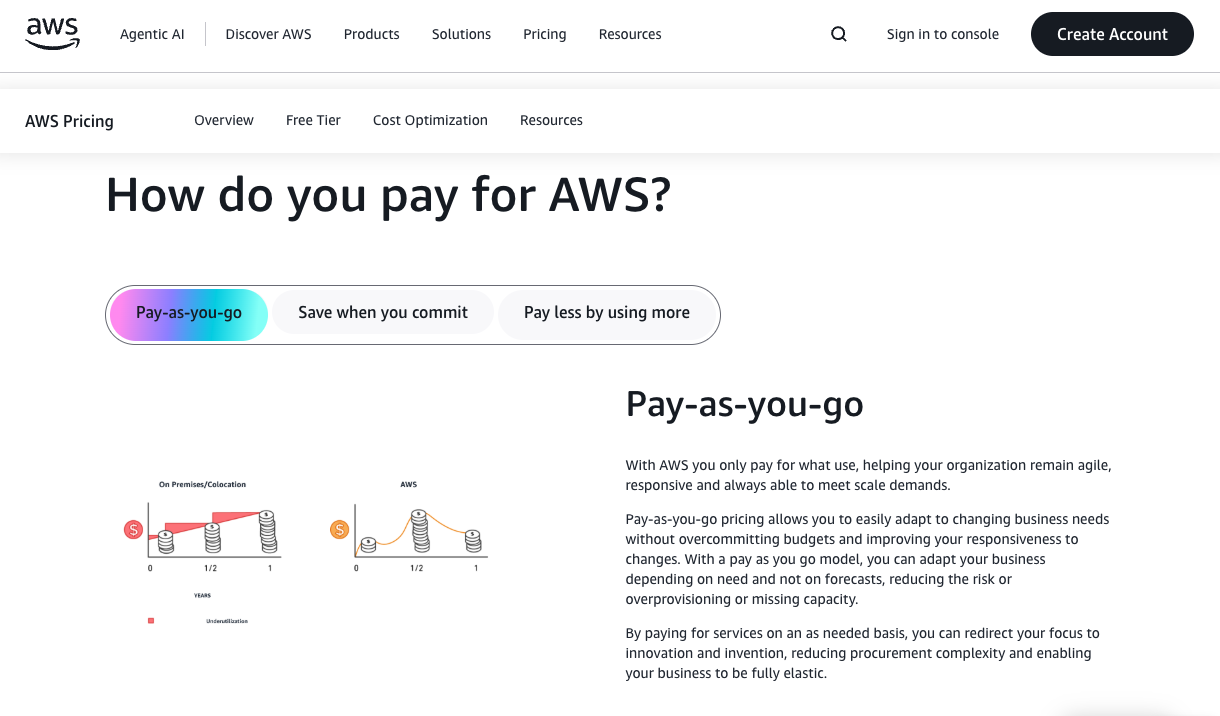
20. “Done-for-You AI” Premium Tier
Hands-on onboarding + custom AI agents = $999/month+
This premium pricing tier offers white-glove onboarding and fully customized AI agents tailored to the client’s specific needs. It shifts your AI infrastructure from a product into a high-touch service, providing personalized setup, integration, and ongoing support—ideal for enterprise clients who demand bespoke solutions and are willing to pay a premium.
- Use this as enterprise wedge – Opens doors to large accounts by addressing complex requirements and building deep partnerships.
- Turn AI infrastructure into service revenue – Moves beyond software licensing into recurring services with higher margins.
Real‑World Example: AIAgent app Done‑for‑You Plans
AIAgent app offers a hands‑on, enterprise‑focused service tier designed around delivering fully managed AI workflows: Custom “Done‑For‑You” plans begin at $5,999/month or more.
- These plans include:
- A 60‑minute deep‑dive audit and roadmap mapping AI workflows to existing business processes
- 2 complex AI workflows built every month; design, deployment, testing, and revisions included
- Weekly strategy and optimization calls to refine performance
- Unmetered revisions, 24‑hour support, and dedicated AI engineering team
- Integration across 15+ enterprise systems (CRM, marketing tools, analytics, etc.)

Final Thoughts
AI-native B2B startups aren’t just improving old processes—they’re creating entirely new value chains and business models that didn’t exist before. This means the traditional SaaS pricing playbooks don’t apply anymore. You’re not selling static software seats or simple feature sets; you’re delivering intelligent automation, dynamic workflows, and outcomes that can transform how businesses operate.
If you try to fit your AI-powered product into outdated pricing frameworks, you risk leaving massive value—and revenue—on the table. Instead, start with the value you deliver. Price based on outcomes, usage, and the unique ways your AI impacts customers’ bottom lines. Craft packages that reflect the complexity and magic of your technology. Package your product like it’s 2025, not 2015.
Your pricing should be smart, flexible, and aligned with your customers’ success. That’s the key to unlocking growth, minimizing churn, and positioning your startup for long-term success in the AI-native economy.
Ready to move fast and get your pricing strategy live in days, not months?
Atlas is the first platform built specifically for AI-native startups that want to build sophisticated pricing and billing engines without the usual headaches. We provide everything you need to monetize smarter, faster:
- Beautiful, conversion-optimized pricing pages designed for AI products
- Data-backed pricing strategies tailored to complex usage and value models
- Seamless checkout flows that reduce friction and boost conversions
- Robust, flexible billing logic to handle usage-based, seat-based, and hybrid models
- Scalable tier structures that grow with your customers
- Powerful revenue analytics and insights to optimize pricing continuously
No more manual spreadsheets or guesswork. Atlas gives you the plug-and-play monetization infrastructure so you can focus on building your AI product—and scaling your business.
Don’t settle for “ pricing 1.0” in an AI-powered world. Let Atlas help you unlock pricing that truly reflects the value you create.
Ready to Go From Idea to Revenue?
Atlas gives you everything you need, pricing strategy, checkout, billing, analytics, and more to start making money.

.png)
